


Framed or unframed, desk size to sofa size, printed by us in Arizona and Alabama since 2007. Explore now.
Shorpy is funded by you. Patreon contributors get an ad-free experience.
Learn more.

- Baldwin 62303
- Baldwin VO-1000
- Cold
- No expense spared
- Tough Guys
- Lost in Toyland
- And without gloves
- If I were a blindfolded time traveler
- Smoke Consumer Also Cooks
- Oh that stove!
- Possibly still there?
- What?!?
- $100 Reward
- Freeze Frame
- Texas Flyer wanted
- Just a Year Too Soon
- WWII -- Replacing men with women at the railroad crossing.
- Yes, Icing
- You kids drive me nuts!
- NOT An Easy Job
- I wonder
- Just add window boxes
- Icing Platform?
- Indiana Harbor Belt abides
- Freezing haze
- Corrections (for those who care)
- C&NW at Nelson
- Fallen Flags
- A dangerous job made worse
- Water Stop
Print Emporium
Stoves and Ranges: 1910
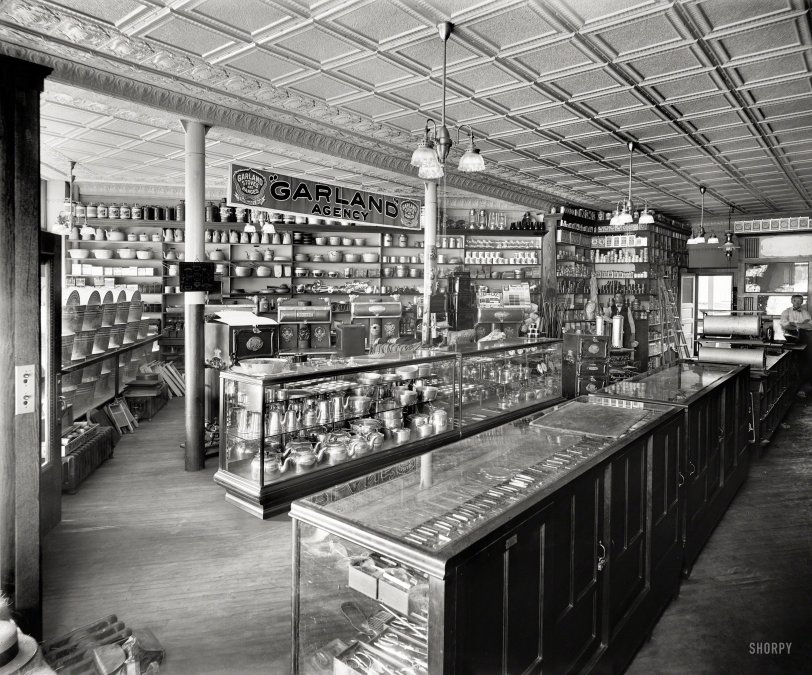
Detroit circa 1910. "Pickard Gas Co. -- Store interior with gaslight fixtures and Garland Agency display of stoves." One-stop shopping for washtubs, teakettles and croquet sets. 8x10 glass negative, Detroit Publishing Co. View full size.
Scrubbing Boards
I watched my mother use one of them in our old cast iron claw-footed bathtub back in the 1940's. We didn't have the heavy duty concentrated detergents back then that are so common now. Kids' socks were amongst the worst clothing items to get clean and were usually scrubbed before placing them in the wringer washer.
I was looking for a scrubbing board at some point back in the 1970's. I walked into a hardware store that carried everything. If they didn't have it, it didn't exist. The clerk looked at me like I had 7 heads! He pointed out one could only be found in an antique shop and at a price that was much more than what my old mother paid for hers back in the day!
Garland: "The Line of the Leader"
Now owned by Manitowoc, the modern Garland range is still manufactured and used world-wide. I used to make these bad boys when I was a kid, and they were in every professional kitchen and "all the ships at sea." They were extemely sturdy appliances -- real workhorses. Canadian-made and US-made and shipped everywhere. A bit of history may be found here.
Knob and Tube
Our house was first built in 1954, and was probably very near the end of the K&T wiring era. We have extensively remodeled since buying it in 1969, but there is still one interior wall with the old wiring.
Properly installed and left without someone accidentally cutting into it in a wall, that style was actually quite safe. All joints were soldered and heavily taped, and wiring runs separated the heavily insulated hot and neutral wires widely, so the chances of an accidental short was pretty slim.
Still working a century later
We had the same push button light switches in a 1918 house my parents owned when I was a child. Ours were lined up horizontally to each other, rather than vertically. I still see them in houses built during that era.
When we first got that house it had knob and tube wiring, which this place undoubtedly had too. That wiring went bye bye, as a fire hazard, even before we actually moved in. But all the outlets remained original, including the plug outlets, which were in the floors, not the walls.
None of the wiring was in the walls (except for the wires that led to those switches) to put a plug in a wall. It was all between the joists of the floors.
Light Fixtures
The store had some sort of electric light fixtures -- perhaps as Dave said, combination gas and electric fixtures. If you look at the left-hand side of the photo, you'll see, quite prominently, two pushbutton light switches.
[Gas fixtures of the era also had electric-spark ignition. - Dave]
Glidden & (Benjamin) Moore paints
The Jap-A-Lac and Moore House Paint displays next to each other is a sight you'd never see today. Jap-A-Lac was a Glidden product. Today Glidden is now sold almost exclusively at Home Depot. Moore Paints was owned by Robert and Benjamin Moore.
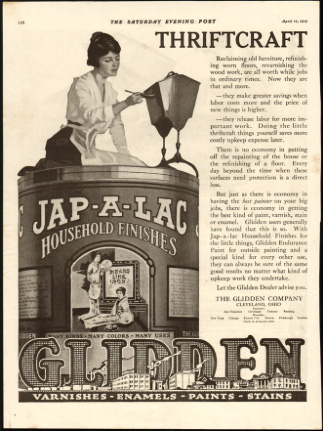
Home On The Range
We sold Welbilt Gas Ranges, they were and might still be the largest stove manufacturers in the world. They bought the Garland Stove Company and made it their high end restaurant cooking equipment brand. At one time the Garland line was inaccessible to us but times were changing. These very expensive cooking devices started being sold to private people looking for gourmet quality appliances in their homes. In the 1960s $5,000 kitchens were in the homes of the well to do. These days 5 Grand won't buy a Wolf or Viking 30" gas range.
They have all the appliances
Even clothes washers! I'll bet they could sell you a clothes dryer too if they have a hank of clothesline.
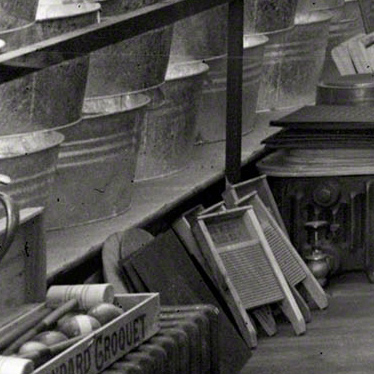
Coffee pots
On the back wall, an array of graniteware/agateware that my wife would KILL for. Especially the big tea kettle. It's porcelain coated tinware, and as it turned out, the porcelain was vulnerable to chipping, so useful life was pretty short. Most got tossed after a couple of years. Sorta rare and valuable now.
Lighting Fixtures
I just love these interior store photos. Oh how I wish I could go back for a day or two and shop! About the lighting fixtures. I believe these have been converted from gas to electric. If you look close, I believe you can just see the bottom of the light bulbs. Besides, if these were gas, shouldn't the jets and globes be facing up instead of down? Just an observation!
[Fixture with gas jets point up; fixtures with gas mantles generally point down. The light fixtures are the reason Pickard Gas Co. commissioned the photo. Each fixture has a pair of chains to regulate gas flow. Below, a similar chandelier from Detroit City Gas Co. These may have been examples of how the gas company was meeting the challenge of electric illumination with some sort of hybrid fixture. - Dave]
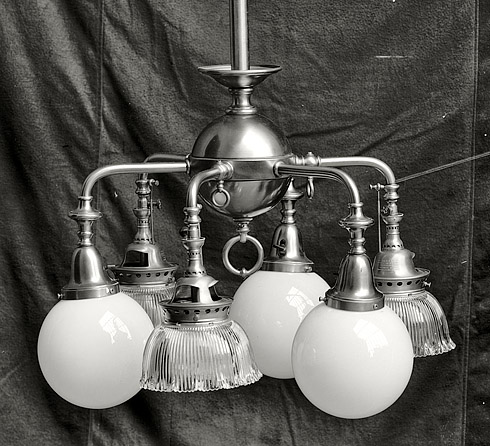
If Antiques Could Talk
Many items in this photo are seen in today's Antique Shops.
Beautiful Gas Lamps!
That Pan
I suspect it is floor-sweeping compound. A mixture of sawdust and oil, I think. Spread on wooden floors, usually on Friday morning. Foot traffic would help it bind with dust during the day, to be swept up with no accompanying cloud of dust on the weekend.
Big rolls of wrapping paper
Before bubble wrap, before styrofoam packing beans, before hard plastic packaging, before white plastic bags.
Also
Up on the counter, a pan of... stuff.
1. A cheap ashtray?
2. Food dish for a Great Dane watchdog?
3. Very small jelly beans?
4. The plant died?
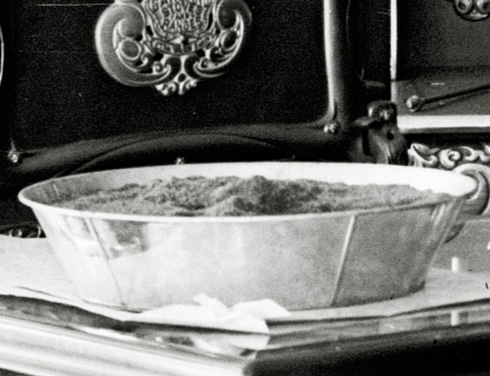
Early photoshop
This appears to be a modified photo. For reasons unknown, the ceiling is sliced and arranged in perspective to an imaginary horizon. Modification of photos has existed for various reasons as long as photos themselves.
[This isn't a "photo," but a scan of the original glass plate negative upon which the exposure was made in the camera. There was no method to make such a modification, nor cause to do so. It's an optical illusion. -tterrace]
[And if you rotate the picture 90 degrees (or tilt your head), the illusion goes away. -Dave]
























On Shorpy:
Today’s Top 5